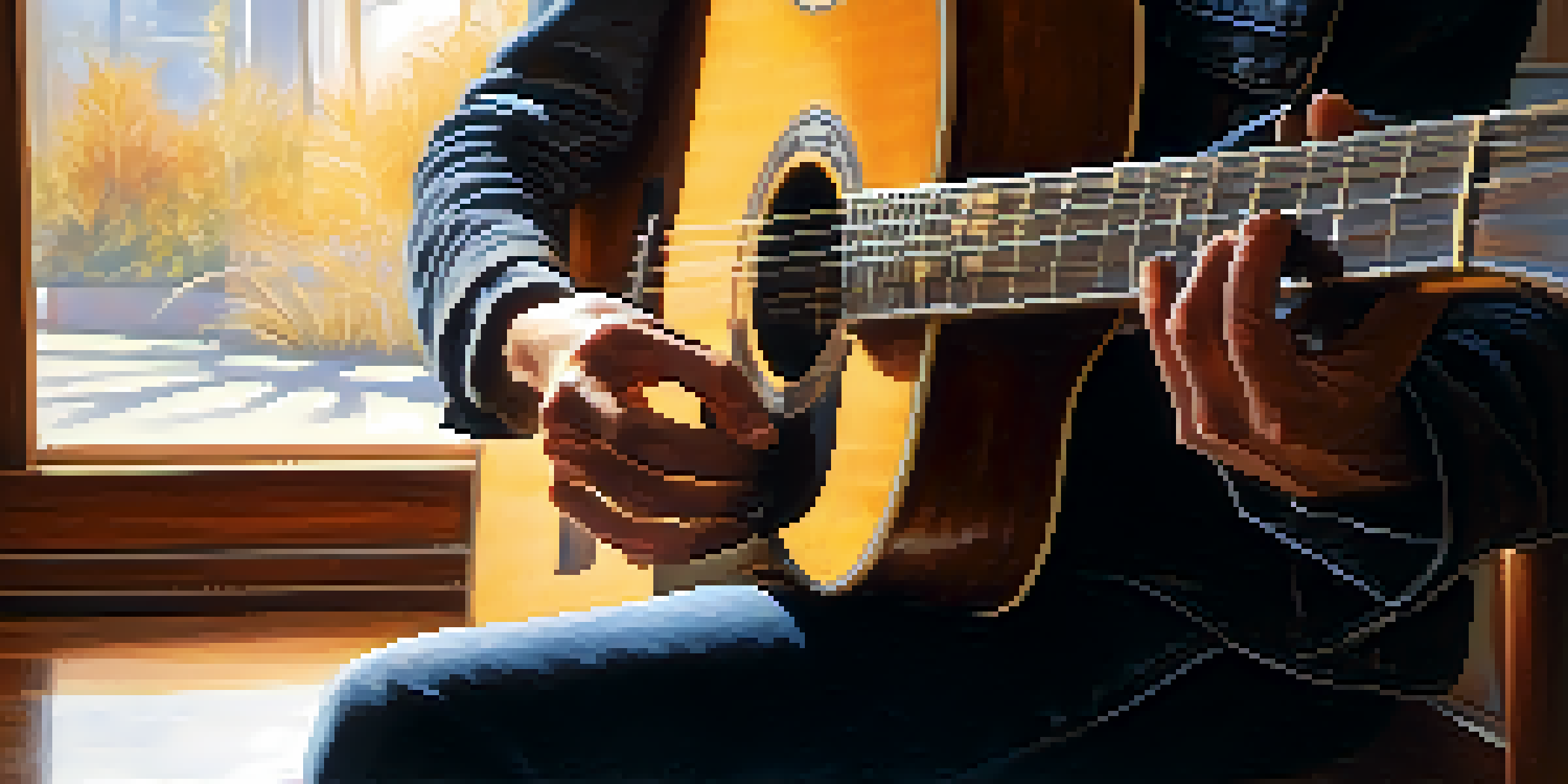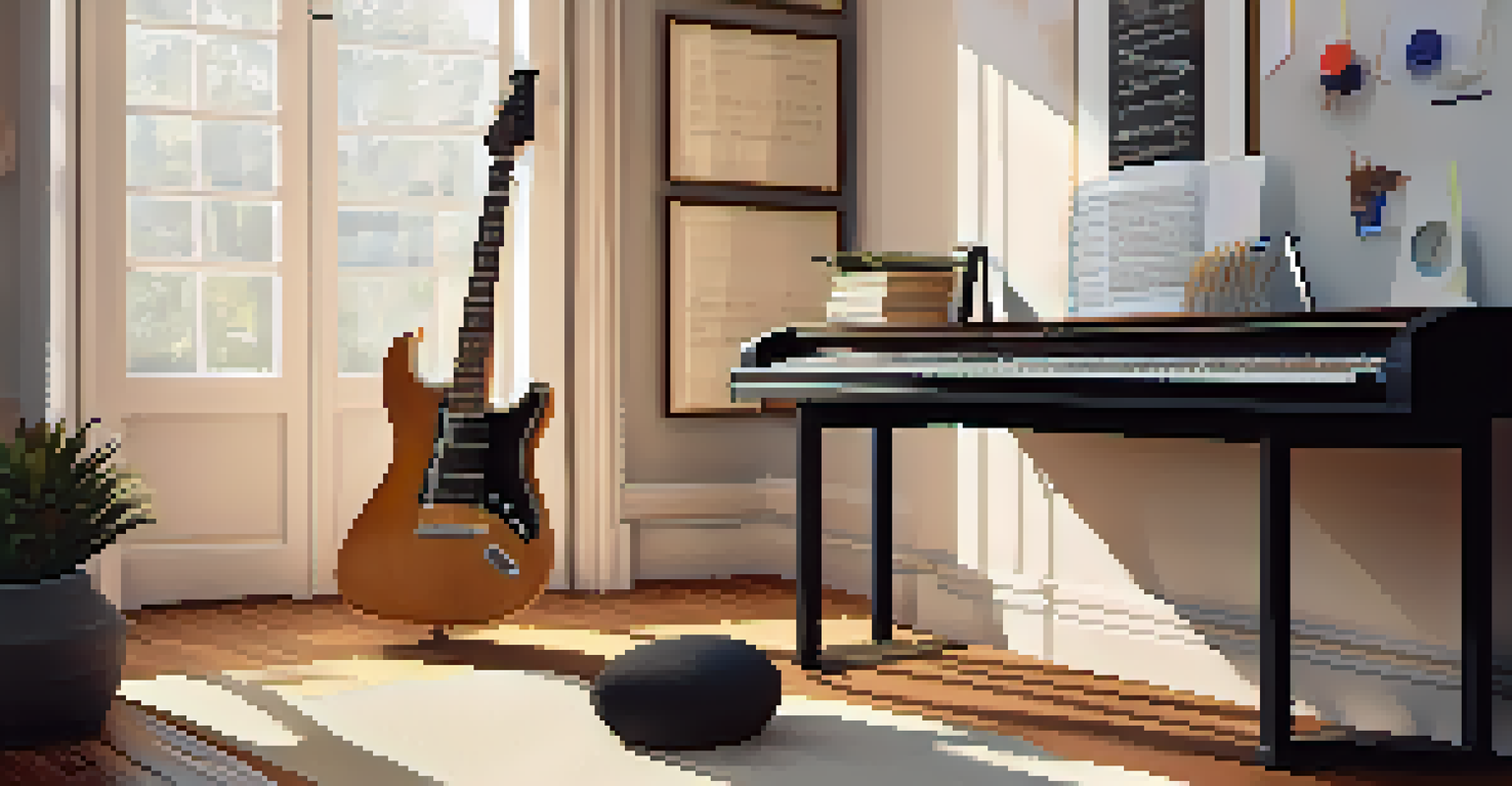How to Structure Your Guitar Warm-Up Routine for Success

Understanding the Importance of a Warm-Up Routine
A warm-up routine is essential for every guitarist, regardless of skill level. Just like athletes prepare their bodies for physical activity, musicians need to warm up their fingers and minds to perform at their best. This practice not only enhances your technique but also helps prevent injuries and strain.
The more you practice, the better you get, the more freedom you have to create.
Moreover, a well-structured warm-up can boost your confidence and set a positive tone for your practice session. It allows you to focus on your playing without the frustration of stiff fingers or a distracted mind. Think of it as a way to ease into your practice, much like stretching before a run.
Lastly, a consistent warm-up routine can lead to long-term improvement. By incorporating specific exercises into your daily practice, you’ll notice gradual enhancements in your dexterity, speed, and overall musicality.
Setting Clear Goals for Your Warm-Up
Before diving into your warm-up routine, it’s crucial to establish what you want to achieve. Are you looking to improve your speed, finger independence, or perhaps your chord transitions? Clearly defined goals will guide your warm-up exercises and make your practice more effective.

For instance, if your goal is to enhance your finger dexterity, including finger stretching exercises or scales may be beneficial. On the other hand, if you're aiming to improve rhythm, consider incorporating strumming patterns or metronome work. By aligning your warm-up with specific goals, you’ll stay focused and motivated.
Warm-Up Routines Boost Performance
A consistent warm-up routine enhances technique, prevents injuries, and prepares your mind for practice.
Remember, your goals can evolve. Regularly reassessing them allows you to adapt your warm-up routine to your current needs, ensuring continual growth as a guitarist.
Incorporating a Variety of Exercises
Variety is key when structuring your warm-up routine. Mixing different exercises keeps things fresh and engages various muscle groups. For example, you could alternate between scales, arpeggios, and finger exercises to cover a broad spectrum of skills.
Success is where preparation and opportunity meet.
Additionally, consider incorporating both technical and musical elements. While technical exercises enhance your finger agility, playing simple melodies can warm up your musical ear and creativity. This blend not only prepares your hands but also primes your mind for creative expression.
Ultimately, having a diverse routine can prevent boredom and keep you excited about your practice. Experiment with different exercises until you find a combination that works best for you!
Establishing a Time Frame for Your Routine
Time management plays a significant role in an effective warm-up routine. Determining how much time you can dedicate to warming up each day will help you select appropriate exercises. Even a short, focused ten-minute routine can yield great benefits if done consistently.
For instance, if you have only 15 minutes, consider spending 5 minutes on scales, 5 minutes on finger exercises, and 5 minutes on a musical piece. This structured approach ensures you cover multiple areas without feeling rushed. The key is to be intentional with your time.
Set Specific Goals for Warm-Up
Establishing clear goals for your warm-up helps tailor exercises to your needs and maintains motivation.
As you progress, you can adjust the time spent on each exercise based on your needs and goals. Flexibility in your routine allows you to remain adaptable while still maintaining a strong foundation.
Using a Metronome to Enhance Timing
Including a metronome in your warm-up routine can significantly improve your timing and rhythm. By practicing scales or exercises with a metronome, you’ll train your ear and fingers to stay in sync, which is crucial for any guitarist. Start slow, and gradually increase the tempo as you become more comfortable.
For example, when practicing scales, set the metronome at a comfortable speed, making sure you play each note cleanly and accurately. Once you feel confident, gradually increase the tempo to challenge yourself. This methodical approach helps reinforce good habits and builds your speed over time.
Additionally, using a metronome can be a great way to track your progress. As you become more proficient, you’ll notice yourself able to play faster and cleaner, providing a tangible sense of achievement.
Listening and Adjusting During Your Warm-Up
Listening to your playing is just as crucial as the exercises themselves. As you warm up, pay attention to areas that feel stiff or require extra focus. This awareness allows you to adjust your routine on the fly, targeting specific issues that may arise.
For instance, if you notice that certain chords sound muddy or unclear, spend additional time focusing on those transitions during your warm-up. By actively listening, you can identify weaknesses and address them before they become ingrained habits.
Diverse Exercises Keep Practice Engaging
Incorporating a variety of exercises prevents boredom and engages different skills, enhancing overall musicianship.
Moreover, this reflective practice can lead to greater overall improvement in your musicianship. Developing an ear for your playing fosters a deeper connection with your instrument and enhances your overall performance.
Creating a Consistent Daily Routine
Consistency is the cornerstone of any successful warm-up routine. Aim to incorporate your warm-up into your daily practice, making it a non-negotiable part of your routine. The more consistently you warm up, the more natural it will feel and the greater the benefits you’ll experience.
Consider setting a specific time for your warm-up, whether it's first thing in the morning or right before your practice session. By establishing this habit, you signal to your brain that it's time to focus and prepare for your musical journey.

Over time, this daily commitment will lead to noticeable improvements in your playing, making your warm-up an essential component of your growth as a guitarist.